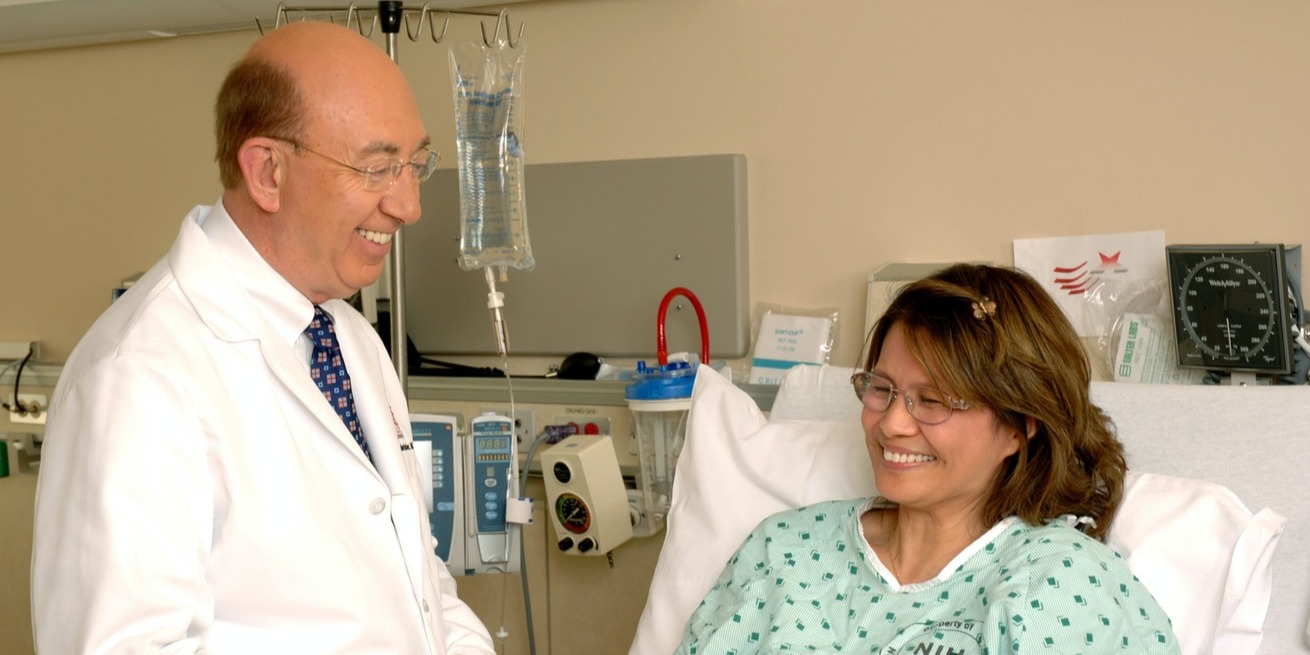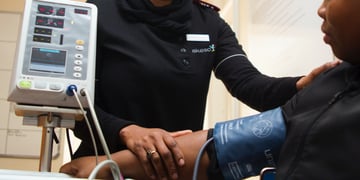How to Measure and Improve Patient Satisfaction Scores in the Covid Era
6 minute read | 24/09/2021

Patient satisfaction in the Covid era is a difficult topic for most healthcare professionals to broach.
Facilities across the UK are facing a considerable backlog of people waiting for care (at a record 5.45 million, as it stands), patients with greater feelings of isolation and anxiety and a steady influx of positive Coronavirus cases, new strains and research recommendations.
Needless to say, measuring and improving patient satisfaction scores is on the top of everyone’s mind. We can all deduct that the pressure on healthcare facilities has been felt across the board, undoubtedly impacting patient experience. However, it’s a complex web to consider and a scary statistic to focus on, revealing just how profound an impact the pandemic has had on the NHS and its patients.
The onslaught of patients needing intensive, responsive and completely monitored care has meant that the NHS has been pushed into survival mode, primarily delivering the care necessary to treat its patients. Because of this, it has been unable to focus on the, in the grand scheme of a pandemic, less important subject of patient experience. Yet, since the other key figures are starting to stabilise, infection rate and admission rate amongst them, it’s time to turn our attention to one of the metrics that holds the most importance: patient satisfaction.
- Patient Satisfaction in the Covid Era
- Measuring Patient Satisfaction Scores
- Improving Patient Satisfaction Scores
- Increasing Patient Happiness Through Efficiency and Reinvestment
Patient Satisfaction in the Covid Era
Patient satisfaction has always been a key metric for every hospital and healthcare facility. But now, more than ever, patient satisfaction is high on the healthcare agenda.

Coronavirus restrictions have seen patient satisfaction scores suffer for a number of reasons. National restrictions have meant visitation hasn’t been possible for most, decreasing the lack of interaction and heightening the feeling of isolation for those in hospital. In positive Coronavirus cases, hospital restrictions have also stripped doctor-patient interactivity, to some degree. Reliance on patient entertainment has increased and so too has the scrutiny of such systems.
Many patients are starting their hospital stay on the ‘wrong foot’ feeling less supported and engaged than they normally would. This, paired with the spike in bed occupancy, means patient satisfaction is tough to control, especially when staff are tending to a higher than average patient number.
For example, an NHS patient survey outlining the inpatient experience during Covid-19 found:
- 24% of people said they were ‘sometimes’ or ‘never’ able to understand the information that staff gave them
- 27% said staff information was often ‘contradictory’
- 27% said they could ‘sometimes’ or ‘never’ understand staff when they were talking while wearing PPE
- Particular patient demographics―those aged over 85, people with dementia or Alzheimer’s, patients who are deaf and hard of hearing, autistic people and those with a learning disability—suffered to understand staff the most
- 13% of patients said they didn’t receive the help they needed to keep in touch with friends and family
- Those with COVID-19 report poorer patient satisfaction results with 29% claiming they didn’t receive the post-discharge care and support they needed
Indeed, Coronavirus has impacted every aspect of the patient experience, in some way.
From the difficulties of relaying information while wearing PPE to the impact of an increased workload in tandem with increased responsibilities, it seems almost impossible to stabilise scores in the current climate and meet CQUIN targets.
Just collecting and measuring patient satisfaction scores seems like a great feat, adding yet another task to a bulging workload.
Measuring Patient Satisfaction Scores
Typically, patient satisfaction scores are collected through paper surveys and verbal feedback which is then manually inputted into a scoring system or yielded via digital touchpoints.
However, this isn’t the quickest or most convenient route to obtaining patient feedback.

Patient feedback is more easily measured via a digital patient engagement platform where data can be inputted on personal devices and tracked using an analytics system. Patients can be prompted to give feedback, without requiring any staff involvement.
Uptake also increases via this method as patients can fill out surveys at their leisure. As patients feel more comfortable giving candid feedback in private, the accuracy of patient satisfaction scores is also greater when using digital platforms.
Our analytics platform SPARK® Analytics integrates with surveys and allows healthcare facilities to link to digital surveys analyse data through their own account.
What’s more, improving patient satisfaction can also be helped by the same system.
Improving Patient Satisfaction Scores
Digital patient engagement platforms (PEPs), first and foremost, are designed to better engage patients through a range of features including enhanced entertainment and access to healthcare information.
They help to measure patient satisfaction scores—but they play an even more important role in improving them.
.jpeg?width=1350&name=AdobeStock_281996819-min-1-min%20(1).jpeg)
Improving Patient Satisfaction with ‘Essential’ Features
Shifting some of the reliance from healthcare staff to a digital patient engagement system means patients can find information, contact loved ones and access entertainment independently. For example, with SPARK® Media, patients can:
- Access free live TV on demand using their own device
- Research treatment
- Order meals tailored to their dietary needs
- Watch educational videos specific to their condition/diagnosis
- Send requests to staff for essential items such as a glass of water or a pillow
Watch a short video that outlines exactly how SPARK® Media can make a real difference.
In turn, patient satisfaction scores start to improve, even for the most vulnerable demographics, while healthcare staff gain back valuable time spent conducting menial tasks to set aside for more impactful activities that relate to the quality of treatment.
Many of these features—matched entertainment quality to the home environment and patient specific information—are now seen as an essential, not a bonus. They’ve come to be known as a standard, especially during social distancing.
Providing More Than Independent Aid
The features of such systems can also aid staff interaction, helping to highlight key information and explain it through visual cues like a digital copy of a test result or an X-ray image.
With the added obstacle of PPE, the need for other means of communication has never been so important. So, while digital patient engagement systems are largely designed with independent use in mind, they also help healthcare providers and their patients to communicate, allowing digital documentation to fill the gaps in understanding. Doctors and nurses can present information in one click, using other props to deliver difficult news, explain complex health concepts and provide health recommendations or roadmaps through the clinical integration via patient entertainment systems.
Increasing Patient Happiness Through Efficiency and Reinvestment
With a digital patient engagement system, hospitals can avoid stacks of paperwork and smooth out the patient experience by removing the frustration of forms. This is mutually beneficial for both provider and patient, saving time and unnecessary effort for both parties.

Patient engagement systems have a positive snowball effect, as one aspect of patient satisfaction improves, in turn, it enables yet another.
In-built analytics reduces staff time spent on measuring scores and in turn, increases the amount of attention that can be given to patient experience. Patient engagement features allow patients to access entertainment and other services quickly and independently, yet it also removes pressure from hospital staff.
Likewise, when satisfaction is increased and CQUIN targets are met, savings can be repurposed and reinvested to improve treatment offers, guaranteeing even greater results next time.
Despite the impact of the Coronavirus and the unique challenges of the Covid era, digital engagement platforms can rise to the challenge and accelerate digital adoption.
Not only this, but they can also force change that benefits hospitals in the long-term, opening up discussions around engaging the most vulnerable patients, updating entertainment to meet patient expectations and empowering individuals to take control of their own health journey.
Understand The Latest Changes in Patient Engagement Systems
The potential to solve immediate problems and tackle more long-term challenges with a patient engagement system is shaped by regular, data-driven updates that respond to user problems and external changes to the environment. To learn about our latest update post-Coronavirus, click on the link below.
About the author
Rebecca O'Donovan
Becky is the Marketing Director at SPARK TSL, of whom she has worked for since 2012. She is responsible for high-level marketing strategy focusing on lead generation and aiding the vision of the business to ensure business growth.
More articles by the author
Related articles
 Patient Experience
Patient Experience
How to Increase Patient Engagement: 4 Effective Strategies | SPARK TSL
Many patients want to be active participants in managing their own healthcare, but working out how to engage ...
 Healthcare Industry
Healthcare Industry
The Importance of Digital Transformation in the NHS
The way the NHS delivers care was first established in 1948. They have been locked into this service model ...
 Healthcare Industry
Healthcare Industry
NHS Estates Leaders: Reinventing The Wheel No Longer Sustainable
In their second Roundtable of the year, which took place on December 1st, 2023, SPARK® TSL had the ...


